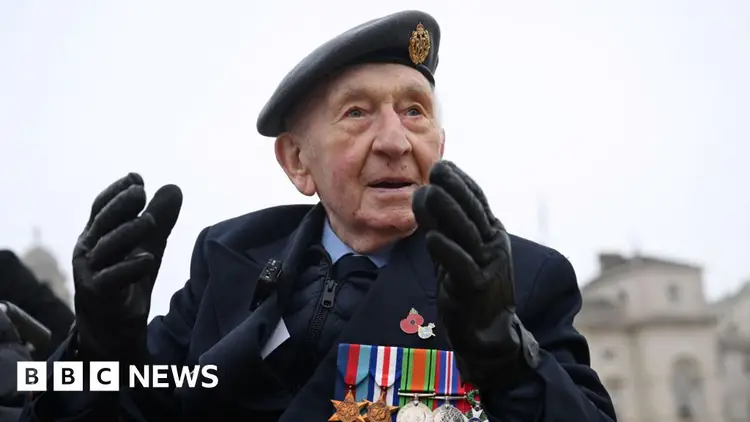Last six D-Day veterans pay tribute on poignant Remembrance Day

One hundred and one-year-old World War Two veteran Joe Randall was present at the event.
Among the thousands of men and women parading by the Cenotaph during this year's Remembrance ceremony, six veterans from D-Day were present.
They have become so scarce that they were overshadowed by the eight former prime ministers who gathered for the annual memorial event in Whitehall, London.
This summer featured a significant global event celebrating the 80th anniversary of the Normandy landings, attended by numerous world leaders and a large press presence.
Beneath the dull, overcast autumn sky, the six surviving members of that monumental and valiant moment—the men who experienced it firsthand—silently rolled by in wheelchairs, adding up to a total age of 595 years.
Among those present was Joe Randall, who is now 101 years old. He was just 20 when D-Day occurred and played a role in constructing temporary airfields to support the invasion effort that aimed to free Europe from Nazi control.
There's a deep emotional significance to these moments, as you witness history slipping away before your eyes.
As a military band played lively marches, the Spirit of Normandy group made their way past the Cenotaph. They were part of a long line of veterans who came to pay their respects, each carrying their own memories as they placed their wreaths.
Just like a marathon runner determined to reach the finish line, the final veteran in the procession had risen from his wheelchair and was supported onto a walking frame, allowing him to stand tall as he made his way past the Cenotaph.
He resisted the march of time in his own quiet way, taking a moment to honor the occasion after all the other groups had wrapped up, while the spectators on the sidewalk applauded.
The presence of the youngest group was a moving experience, but in a distinct manner compared to the older veterans in the parade.
Children and young individuals aged nine and older, who had experienced the loss of a parent in the military, were united by the charity Scotty's Little Soldiers. They faced many years ahead of living without their loved ones.
Children who have lost parents in the armed forces also participated in the parade.
At these events, you can feel how crucial time is.
The sound of Big Ben ringing out over Whitehall marks the hour. It's the final moment, a two-minute period of silence. The band sets the pace as the marchers fall in line. Autumn leaves scatter on a traffic-free Whitehall.
For a brief period, some individuals even accomplished the unimaginable by setting aside their mobile phones.
The main topic was King Charles and his reflections on the past year. What was on his mind?
He has continued to work even while battling cancer. This week, on his 76th birthday, he plans to volunteer at food banks. As he gazed contemplatively at the Cenotaph, one might wonder if this reflected his dedication to serving others, his sense of responsibility, and his resilience.
Catherine, the Princess of Wales, gazed out from the balcony of the Foreign Office, taking a moment to recuperate after experiencing her own health struggles over the past year. A lot has shifted since she last stood in that spot.
The Princess of Wales observed from the balcony of the Foreign Office.
This year has brought a unique kind of change for the politicians in attendance. Sir Keir Starmer and Kemi Badenoch were honoring the occasion by laying wreaths for the first time in their roles as prime minister and leader of the opposition.
It was a day to reflect on past wars, but the newly appointed ministers were likely contemplating the current conflicts as well and considering the potential consequences of those struggles.
In the background of Sir Keir's position, a Ukrainian flag was drooping lazily from the Foreign Office building, unmoved by any breeze.
For everyone in attendance—whether they are royals, veterans, political figures, or members of the crowd—the central point of Remembrance is the Cenotaph, the monument located at the heart of Whitehall.
It transforms into both a shrine and a memorial, as Whitehall temporarily turns into a blend of a place of worship, a military display area, and a national tribute.
One reason the Cenotaph is so impactful is its simplicity. It lacks elaborate decorations or religious symbols. This unadorned design allows it to resonate in today’s diverse and multifaceted society, where people from over 20 different faiths and belief systems come together.
The Cenotaph that we see today is a lasting monument crafted from Portland stone, but it originally started out as a temporary wooden design. Some individuals believed it shouldn't be situated on Whitehall because it could obstruct the area.
Maybe that's the whole idea behind it. It's purposefully designed to disrupt, serving as an uncomfortable prompt that encourages people to recall things they might want to ignore.























































